Ekundayo E.O. Environmental monitoring
Подождите немного. Документ загружается.

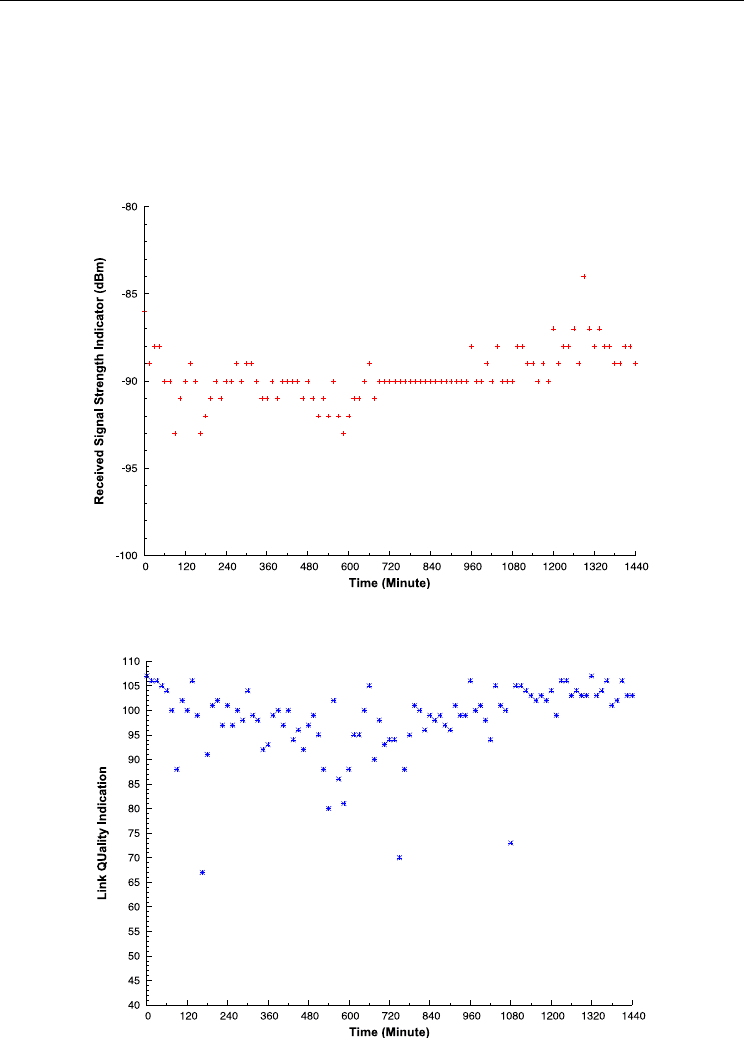
Environmental Monitoring WSN
491
2. The higher LQI results in a more stable PRR. The relationship between LQI and PRR
shown in Fig. 5 (b) is less clear than Fig. 5 (a). Similar results are also addressed in
(Lin et al., 2006). According to these observations, RSSI should be used to relate to the
PRR.
3. The LQI significantly increases with the RSSI. Convergence to particular LQI values is
then observed. A lower bit error rate is observed when the base station receives packets
with higher RSSI measurements.
Fig. 4. (a) Fluctuation in link quality metrics over 24 hours RSSI
Fig. 4. (b) Fluctuation in link quality metrics over 24 hours LQI
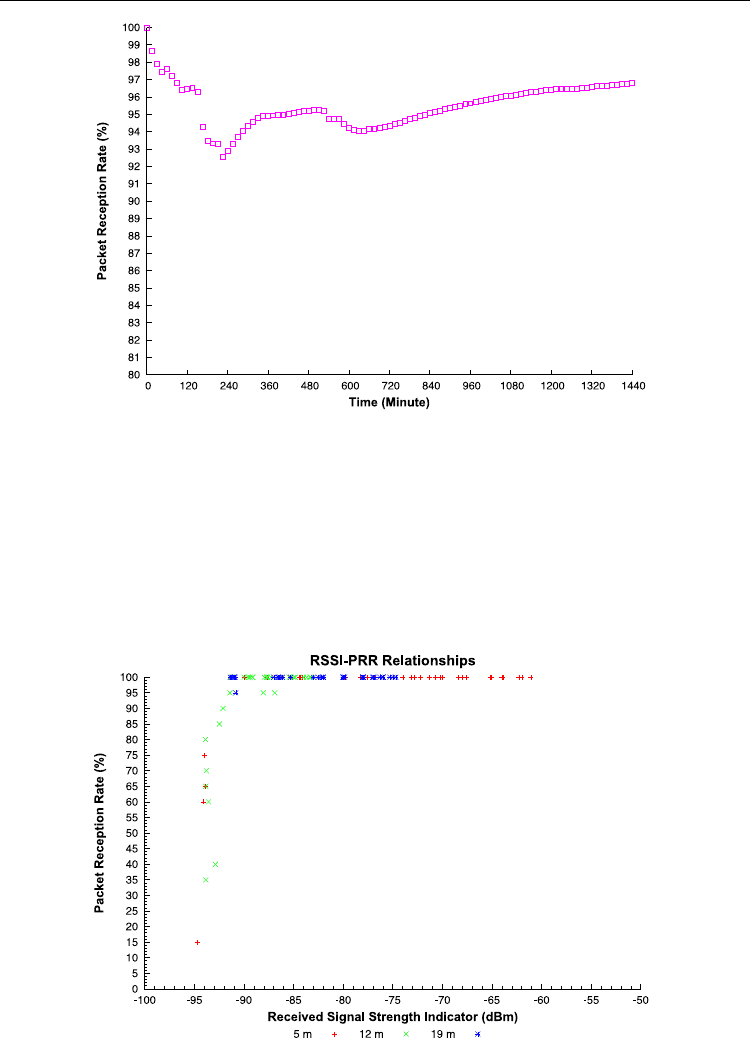
Environmental Monitoring
492
Fig. 4. (c) Fluctuation in link quality metrics over 24 hours PRR
The relationship between link quality metrics can be used to estimate an observed reliability
from the measured receiving strength. This observation is addressed in (Lin et al., 2006) and
(Srinivasan et al., 2006). After measuring the metrics, the base station determines whether
the current transmission power requires an adaptation. The PRR steeply increases with the
RSSI followed by significantly more stable measurements. The PRR should not be estimated
from the RSSI between -95 to -90dBm as transmission power adaptation based upon this
region will not be accurate. The measurements demonstrate that the network should operate
at levels taken from an appropriate region.
Fig. 5. (a) Relationships between metrics RSSI-PRR
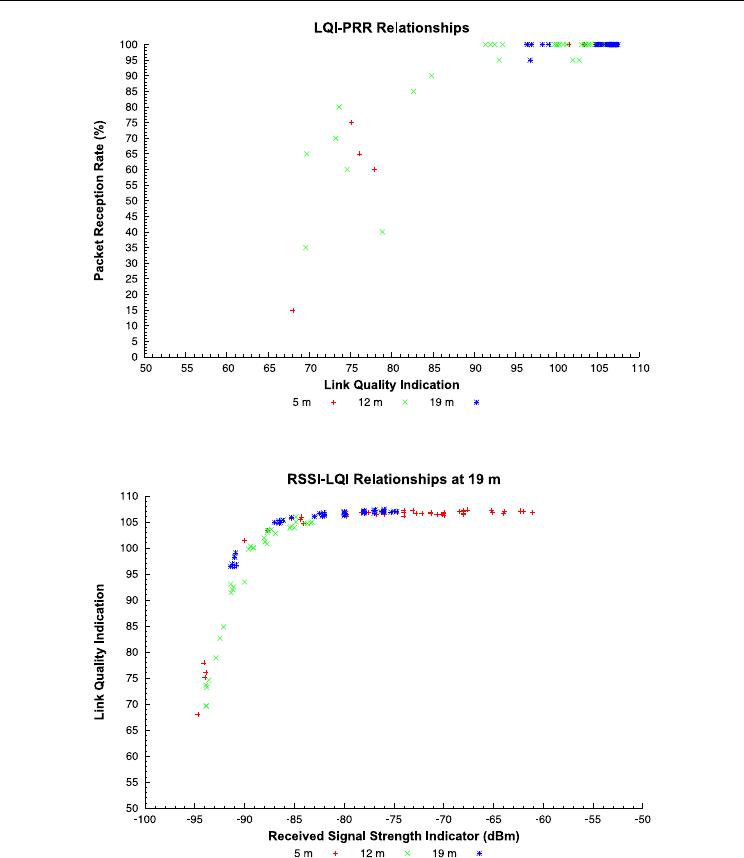
Environmental Monitoring WSN
493
Fig. 5. (b) Relationships between metrics LQI-PRR
Fig. 5. (c) Relationships between metrics RSSI-LQI
4.3 Delays in wireless sensor network
This section provides some experimental results on delays in wireless sensor network
(WSN) which affects PoRAP architecture development. Communication is represented by a
frame structure which consists of several slots. A slot is assigned to each source and it
transmits data when the allocated slot arrives. The slot length should be long enough to
avoid data collisions at the base station where two packets from two different sources arrive
approximately at the same time. Several experiments have been conducted in order to
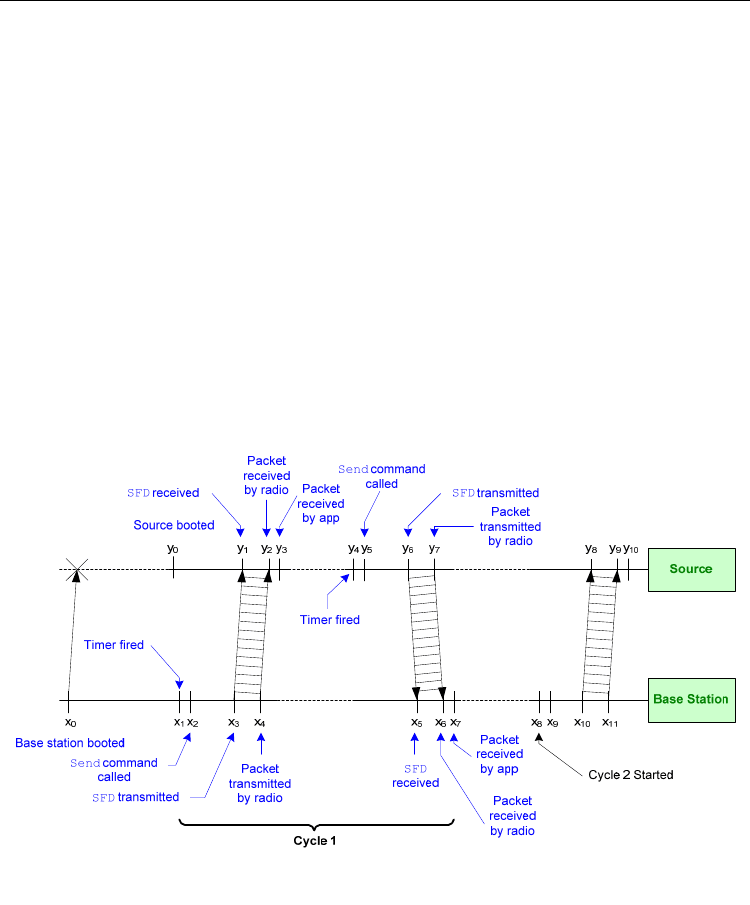
Environmental Monitoring
494
investigate some factors which affect the delays, including heterogeneity in sensor
manufacturing and payload sizes.
4.3.1 Timestamp measurements and delay calculations
Details of timestamping scenario and delay calculations are given. As the base station does
not know when the source is booted, at the beginning it broadcasts the control packet
periodically. The periodic broadcast was set to 1 second. After the source is booted, it starts
its transmission after the packet has been received. Similarly, the base station starts the next
transmission after it has received the packet back from the source. Packet timestamping
mechanisms and delay calculations are respectively illustrated in Fig. 6 and Table 4.
According to Fig. 6, the base station is booted at x
0
. When the base station is ready to send,
the timer is set to be fired at x
1
and send command is called at x
2
. A timer is used in order to
trigger packet transmission. Prior to transmission, the base station sets some fields in the
message structure such as its id and transmission power. The SFD (Start of Frame Delimiter)
transmission occurs at x
3
. The timestamp is created and the packet payload content is
modified to include the time of the transmission. Therefore, the fire-to-send and send
command delays of the base station are equal to x
2
– x
1
and x
3
– x
2.
The packet is completely
transmitted by the radio at x
4
and the transmission delay is x
4
– x
3
.
Fig. 6. Timestamp at various events
After being booted at y
0
, the source receives the SFD at y
1
. The receive event of the radio and
application are signalled at y
2
and y
3
when the source receives the packet. The reception and
receive delays of the base station are therefore y
2
- y
1
and y
3
– y
2
. Once the packet has been
received, the source requires some duration to process the information obtained from the
packet. It then sets up its own transmission and the bits of packet are loaded into the radio
buffer. The timer is fired at y
4
and the send command is called at y
5
. The SFD is transmitted
at y
6
. Hence, the send command delay of the source is equal to y
6
– y
5
. The transmission
delay is y
7
– y
6
. Table 4 summarises the delay calculations.

Environmental Monitoring WSN
495
Dela
y
s Calculations
Base Statio
n
Fire-to-Send
x
2
–x
1
Send Command Dela
y
x
3
–x
2
Transmissio
n
x
4
–x
3
Receptio
n
x
6
–x
5
Receive
x
7
–x
6
Source
Receptio
n
y
2
–
y
1
Receive
y
3
–
y
2
Fire-to-Send
y
5
–
y
4
Send Command Dela
y
y
6
–
y
5
Transmissio
n
y
7
–
y
6
Two-Wa
y
Pro
p
a
g
atio
n
(x
5
–x
3
) - (y
6
–
y
1
)
Table 4. Summary of delay calculations
According to Table 4, the transmission and reception delays are calculated based upon when
the events take place. The transmission delay is defined as the duration required for the
radio to transmit the packet. In TinyOS 2.x, the CC2420Transmit interface provides a
sendDone() event which notifies packet transmission completion. The reception delay is the
duration required for packet reception by the radio, and the receive event is used for the
timestamp. The fire-to-send delay indicates the desired interval for starting packet
transmission after the timer is fired.
One Tmote Sky base station and one Tmote Invent source were used. The source was
located at 0.5 m away from the base station. The base station was plugged into a desktop
computer. In total 1,000 cycles of message exchange were run for each source. After the
packet had been received, the node waited for 128ms and initiates its data transmission.
4.3.2 Experimental results
In order to consider the effects of payload size, an additional experiment was conducted. The
scenario shown in Fig. 6 was used. All settings are the same except the payload sizes. In total
five payload sizes were used including 39, 55, 75, 95 and 115 bytes. Note that the maximum
payload for the CC2420 radio is limited to 117 bytes whilst the header size is 11 bytes. Send
command and transmission delays of the source were determined. Two-way propagation
delays were also computed. In the case of 39 bytes, reception and receive delays of source and
base station were observed whilst all delays were observed for the larger payload sizes.
Statistical analysis of fire-to-send, send and transmission delays in milliseconds were
conducted. The relationships between the 50
th
percentiles or medians of all sending delays
and payload sizes are shown in Fig. 7. Note that “Send Command” delay is represented as
“Send” in the figure. The results show that all delays increase with increasing payload sizes.
The source requires more time to deliver larger packets to the radio. Similarly, larger
packets require a longer duration for transmission. Increases in send command and
transmission delays are greater than those of fire-to-send delay.
Statistical analyses of reception and receive delays in milliseconds were also made. The
relationships between the 50
th
percentiles or medians of both receiving delays and payload
sizes are shown in Fig. 8. Linear relationship between reception delay and payload size is
also observed in Fig. 8. The receive delays are constant for all payload sizes.
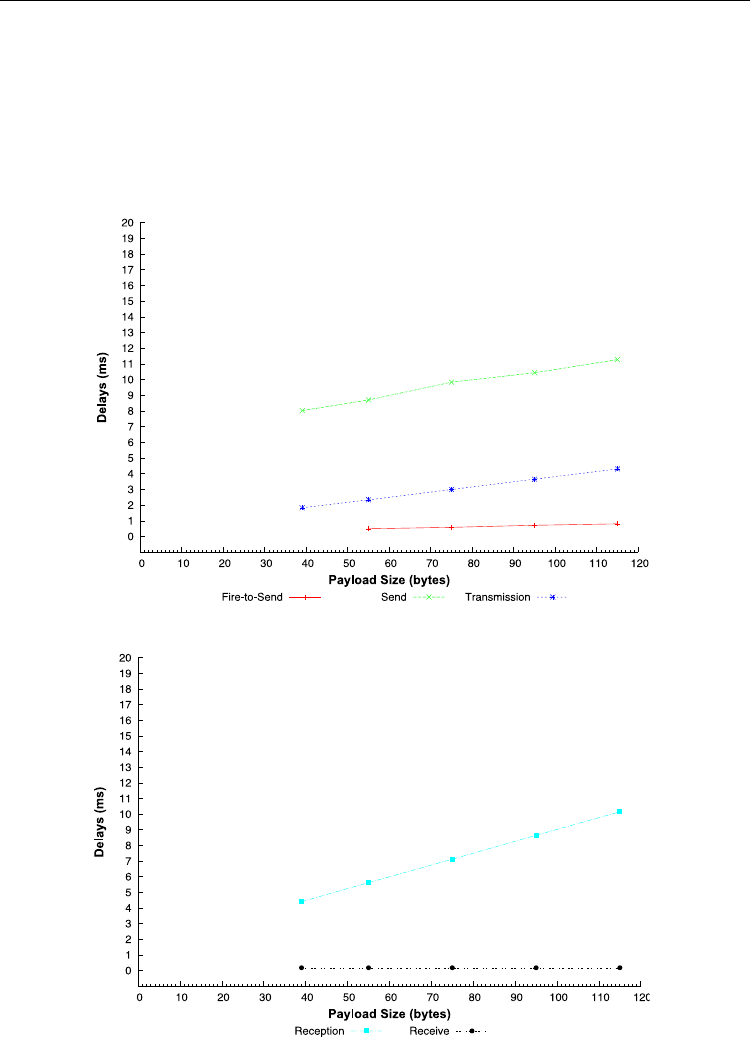
Environmental Monitoring
496
The 32-KHz clock has been used in this experimental study and provides 32,768 ticks per
second. There are 32 ticks in one millisecond. Therefore, the finest precision is
approximately 0.03125 millisecond or 31.25 microseconds. The two-way propagation delays
for all payload sizes are calculated and frequencies of the delay occurrences in ticks are
shown in Table 5.
According to Table 5, frequencies of the 0-tick decrease with increasing payload sizes.
Larger packets require more time to travel from source to destination. However, the two-
way propagation delays are significantly less than the other delays.
Fig. 7. Relationships between source sending delays and payload sizes
Fig. 8. Relationships between source receiving delays and payload sizes

Environmental Monitoring WSN
497
Attribute
Payload Size (bytes)
39 55 75 95 115
Frequencies
0 858 807 785 755 740
1 141 193 212 245 259
2 0 0 3 0 0
Cycles 999 1,000 1,000 1,000 999
Table 5. Frequencies of two-way propagation delays
5. Design of PoRAP
This section describes the design of PoRAP (Power & Reliability Aware Protocol) which
aims at minimising communication energy in wireless sensor network (WSN). The
experimental results stated in previous section inform the design.
5.1 PoRAP main capabilities
In PoRAP, power can be conserved via transmission power adaptation and efficient
medium access management. The selected link quality index is Received Signal Strength
Indicator (RSSI) and it is measured by the base station during data reception. Along with the
awareness of data loss, the adjusted power will often maintain the network operating at the
region where data loss is minimised.
Additional communication can be saved by adopting the schedule-based MAC approach.
Sending and receiving delays can be estimated as they are dependent upon packet size
whilst two-way propagation delay is significantly small. Data transmissions are scheduled
and the sources are mostly in sleep mode to conserve energy. Only one source engages the
shared medium at a time for data transmission. Thus, data collision can be avoided and idle
listening can be minimised. More explanations on PoRAP key capabilities are given as
follows:
5.1.1 Schedule-based protocol
In the single-hop networks, sources are capable of communicating with their base station
directly. This scenario is feasible when the sources and base station are located within
communication range of each other. The base station may be connected to several sensors
which require an access to the shared medium. Uncontrolled medium access possibly leads
to data collisions at the base station. Collision is one of the main sources of power wastage
in the WSN shared medium system. The medium access control (MAC) approach attempts
collision avoidance. There are currently two main approaches proposed for WSN. Firstly,
the medium is sensed to detect any ongoing activities in the medium before conducting data
transmission and reception. This scheme is named contention-based.
PoRAP employs another approach in which each node is assigned a specific duration to
use the shared medium. This scheme is called schedule-based. The other sensors cannot
access and use the medium whilst a sensor is communicating within its time slot. Sources
listen to the base station only once in a frame. Idle listening is therefore minimised.
Moreover, data collisions at the base station can be avoided as there is only one source
sending at a time. The slot length should be long enough to let the source and base station
complete data transmission and reception. This scheme may not be suitable in the case of
multi-hop WSN where each resource-constrained sensor has to maintain slot information

Environmental Monitoring
498
of its neighbours. Furthermore, time synchronisation is required as both sender and
receiver have to orchestrate the data communications to avoid collision caused by the
other receivers.
Centralised scheduling control by the base station is feasible in PoRAP. Slot arrangement
information can be sent to all sensors located in the range. The base station broadcasts a
packet to all sources located in its range. Slot information such as number of slots, slot
length and start time of first slot are included in the payload. Once the first frame is
finished, the base station broadcasts again with the transmission power adaptation
notification.
5.1.2 Communication power conservation
Power constraint should be taken into account when designing a protocol for WSN. Sensors
may be left unattended after being deployed in the remote or hostile environment where
battery recharge or replacement may be costly or infeasible. Communication accounts for
power consumption in WSN. Several sensor platforms provide adaptation to the
transmitting power and the concept of Transmission Power Control (TPC) has been adapted
to WSN. The CC2420 radio employed by Tmote platform, which is used in this research,
supports transmission power (TX) setting. The TX levels are stated by a 5-bit number. There
are therefore 32 possible TX settings provided by the CC2420. In TinyOS, the setPower()
command provided by CC2420Packet interface accepts a value between 0 to 31 for TX
setting. However, the CC2420 datasheet specifies programmable TX in 8 steps from
approximately -25 to 0dBm which are respectively equivalent to the power levels of 3 and
31. The Tmote datasheet follows guidelines given by the CC2420.
Transmission power adaptation policies in WSN should take application specifics into
account. Different applications may require the sources to transmit data at different rates.
For example, an environmental monitoring system may require the current temperature
hourly whilst a surveillance system may require the data every second when an intrusion is
detected. The sensors should be switched to sleep mode after transmission in order to
minimise the idle listening. In a multi-hop network, each node is responsible for routing. It
has to communicate with its neighbours to discover the best path by means of the least
power utilisation. An amount of power is therefore required for listening in the multi-hop.
However, a sensor in the single-hop scenario is capable of transmitting data directly to the
base station. It may be switched to sleep mode after transmission. However, the source has
to listen during the control slot transmission from the base station.
The power adaptation mechanisms in PoRAP do not require historic entries of RSSI and
associated transmission power. The main reason is the limitation of buffering capacity of the
radio chip. The base station should support a significant number of sources. In the CC2420
radio, the maximum buffer size is 128 bytes. Some bytes are required for the header and
other controlling details. Only two bits are used to notify the power adaptation. The RSSI-
PRR relationship obtained from the experimental studies is considered for adaptation as it
suggests the operating region for WSN. In the case of power adaptation, the base station sets
particular bits to notify the source. The sources get the bits and set their transmission power
accordingly.
5.1.3 Link quality monitoring
Radio communication uses air as the transmission medium. There are several attributes
ranging from differences in hardware components to environmental factors such as physical

Environmental Monitoring WSN
499
barriers which affect signal attenuation. Received signal strength estimation is unlikely as
sensors can be placed in various areas of interest. An estimation model should not only
determine distance between sender and receiver as an input, location should also be taken
into account. A shorter distance may not always provide a higher received strength if a
physical barrier appears in the communication line-of-sight (LOS). Moreover, the link
quality metrics fluctuate over the time of day. The observed strength in an indoor
environment may be lower during the nighttime. Applying the simple received signal
strength estimation models, focusing mainly on distance and hardware properties, may not
be sufficient. Therefore, PoRAP employs the measurement-based approach in order to more
accurately adapt the transmission power.
Two link quality metrics are used in PoRAP. The RSSI is obtained by the radio chip whilst
the PRR is specified by the applications. The relationship between RSSI and PRR can relate
the application requirement to the observed link quality. As shown in Section 4.2.5, a clear
relationship between the two metrics is established. The PRR steeply increases with the RSSI
up to a certain point. The PRR is then stable after a certain value of RSSI and a lower RSSI or
TX can be used to obtain the required PRR.
The range of required RSSI is obtained from the reliability requirement and the RSSI-PRR
relationship. This range is recognised by the base station. Upon data reception, the base
station measures the RSSI and compares it to the RSSI thresholds. The adaptation bits are set
with respect to the comparison result. There are three available patterns of bit settings; the
transmission power will be increased if the measured RSSI is lower than require and it will
be decreased if the RSSI is higher. The sources will be notified to retain the current power if
the RSSI is within the range.
5.2 PoRAP architecture
This section aims to describe PoRAP architecture. PoRAP aims at an efficient data delivery
in WSN by means of energy conservation. Input of PoRAP comes from two external
components, the user/application and the monitored phenomenon. PoRAP recognises the
duty cycle and the awareness of data loss. The sensed data is another input and it will be
sent from the source to the base station. In order to achieve the goals, the base station
controls the sources whereas the sources send data to the base station. Required
functionalities of the base station and the sources are then stated. The interactions between
them are described and they are used to address the required components within the source
and the base station. Moreover, the interactions between such components are also given in
this section.
5.2.1 Overview of PoRAP
The main objective of PoRAP development is to provide an efficient data communication in
WSN where the user/application has his/its own requirements such as reliability and duty
cycle. The development of a generic network protocol for WSN is challenging as WSN are
application specific. Fig. 9 shows an overview of PoRAP architecture in terms of the
interactions between its main components.
According to Fig. 9, four main components are addressed including the user/application,
sensed phenomenon, base station and sources. As WSN is application specific, the
user/application has its own set of requirements. The base station directly interacts with the
user/application whilst the sources collect physical directly from the phenomenon. The
functionalities required at the base station and source can be listed as follows:
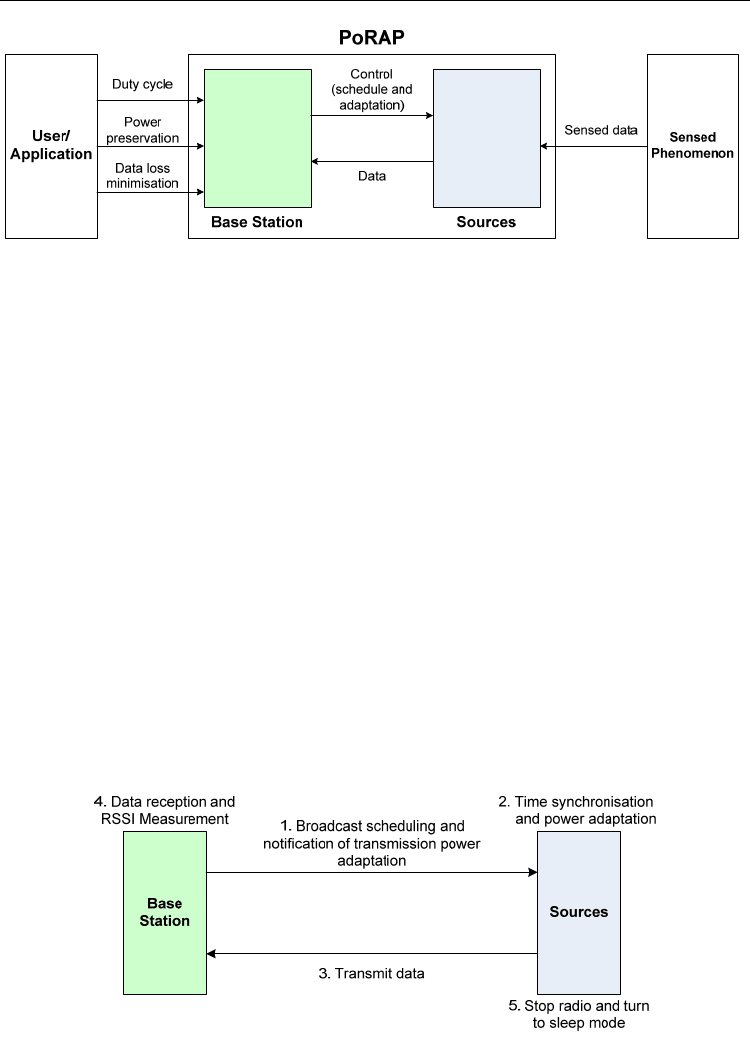
Environmental Monitoring
500
Fig. 9. Overview of PoRAP
Base station:
Recognise the requirements of user/application: PoRAP aims at the low duty cycle
application where the key objective is power conservation instead of throughput.
Examples of this application category are habitat and environmental monitoring systems.
Control the source’s operation: This work focuses on the single-hop network where
direct communication between sources and base station is feasible. No routing is
required at each source and its operation is controlled by the base station in two
aspects. Firstly, the base station determines whether transmission power used by the
source needs to be adjusted by looking at the RSSI. Secondly, the communication cycle
of each source is scheduled in order to avoid data collision and minimise idle listening.
Source:
Collect physical data: WSN has been deployed to collect physical data from the
targeted environment such as temperature and humidity. This work looks at how an
efficient data delivery can be achieved by using lower transmission power whilst data
loss is minimised. The processes of data collection are outside the scope of this study.
Data transmission: After receiving the control information, the source sets two
parameters. Firstly, it synchronises the communication schedule. Thus it will know
when to start the radio for control reception and data transmission. Secondly, the source
adapts its transmission power level according to the included notification. Lower power
can be used and a significant amount of transmission power can be conserved.
Several interactions between the source and base station are required to achieve the
functional requirements and they are addressed in Fig. 10.
Fig. 10. Interaction between sources and base station
